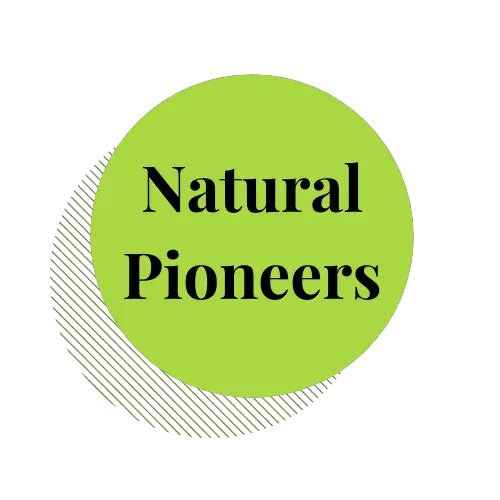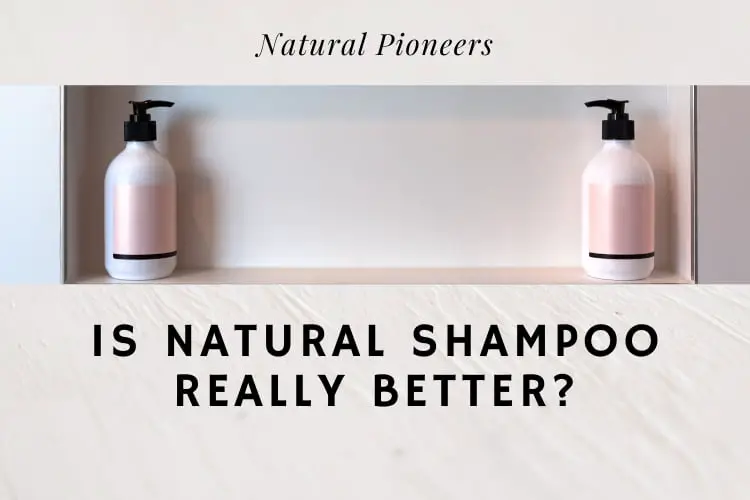
Many brands claim their shampoo is natural and better for hair & health. We’ll tell you what natural means, what to avoid and dive into the safest yet effective products.
Regular shampoos contain many chemicals that are hormone disruptors, cause allergies, cancer & more. The FDA has no definition for “natural” shampoo, therefore any brand can market their product as natural. The best option is non-toxic shampoo. It has the same benefits as regular shampoo & is safe.
We expect a lot from a shampoo. Let’s see what it can really do for us.
1. What We Expect From Shampoo
Long, thick, and shiny hair is what most women want. [1] But can shampoo help us get there?
In the past, shampoo was marketed solely as a cleanliness product. At some point, shampoo migrated from a cleanliness product to a beauty product. It suddenly had all those extra benefits and promised to add volume, clarify, nourish, protect, thicken, repair, add shine, and many more. [2]
To understand how shampoos work, we first need to know a little more about our own hair.
Can Hair Absorb Nutrients?
Hair consists mainly of proteins in particular keratin. [3]
However, the hair shaft, that is our visible hair, is a dead structure. [4], [5]
Therefore, it is impossible for hair to absorb vitamins, minerals, antioxidants or anything else from shampoo. Overall, you should know that if you have ruined your hair, the damaged cannot repair itself. What you can do, however, is somewhat protect and add shine to your hair. Emollients in shampoos and conditioners cover the hair cuticles with a thin layer and can make even damaged hair appear more healthy. [6]
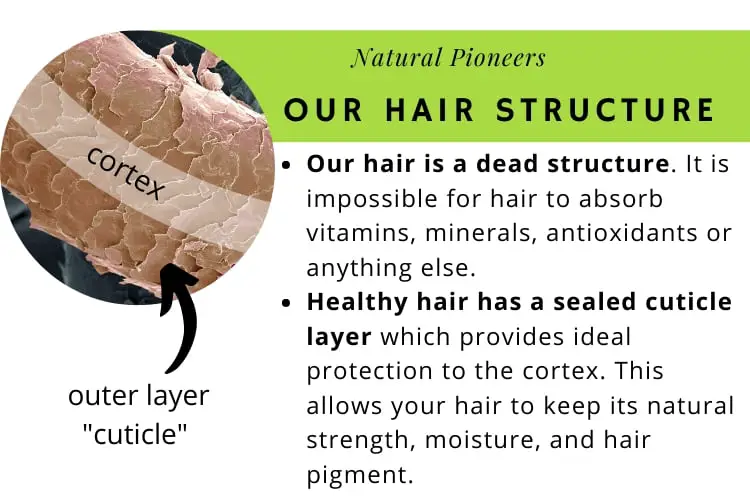
What Is Healthy Hair?
According to research, shine and volume are the essential components for what we refer to as “healthy” hair. [7] However, we just learned that we can enhance the shine by using conditioner. So how do we know if hair is really healthy or if it’s all on the surface?
While hair texture and shine relate to hair surface properties, it’s the integrity of the hair cuticle and hair cortex that tell us in what shape our hair really is. The cuticle is the outermost layer of our hair. It is a hard, shingle-like layer of overlapping cells.
When the cuticle is damaged through heat, products, or treatments, our cortex is in great danger. The cortex of the hair shaft is the thickest hair layer. It also contains most of the hair’s pigment, giving the hair its color, strength, and moisture. [8] When the damage goes as far as to reach the cortex, our hair strands become weak and vulnerable to breaking and splitting.
Healthy hair has a sealed cuticle layer which provides ideal protection to the cortex. This allows your hair to keep its natural strength, moisture, and hair pigment.
How To Keep Hair Healthy
Healthy hair doesn’t always translate to the hairstyle you’re looking for. You might use products to curl or straighten your hair, hair treatments or permanent solutions like Japanese hair straightening, Brazilian blowouts, and keratin treatments. These products all have one thing in common. While they might provide you with the hairstyle you desire, they all damage the cuticle or worse, the cortex of our hair making in weak and vulnerable to breaking and splitting.
To keep your hair healthy, you should essentially stay away from most products and treatments, minimize heat exposure (sun, straightening iron, blow-dryer, …) and use a simple haircare routine including shampoo, conditioner, and perhaps hair masks or leave-in conditioner.
Another crucial aspect is to eliminate toxic exposure. Specific chemicals found in many shampoos, including antimicrobial agents, surfactants and preservatives, can all impair different aspects of hair health. [9] We’ll talk about chemicals soon.
Remember, even if a hair product claims to be nourishing or hydrating, your hair is a dead structure and cannot absorb these products. One thing products can do, is cover the outer layer of your hair to add a little extra protection and shine. [10]
Shampooing is like polishing leather. But, just like polishing shoes, this layer is temporary.
Dr. Jetske Ultee, Research Physician in Cosmetic Dermatology
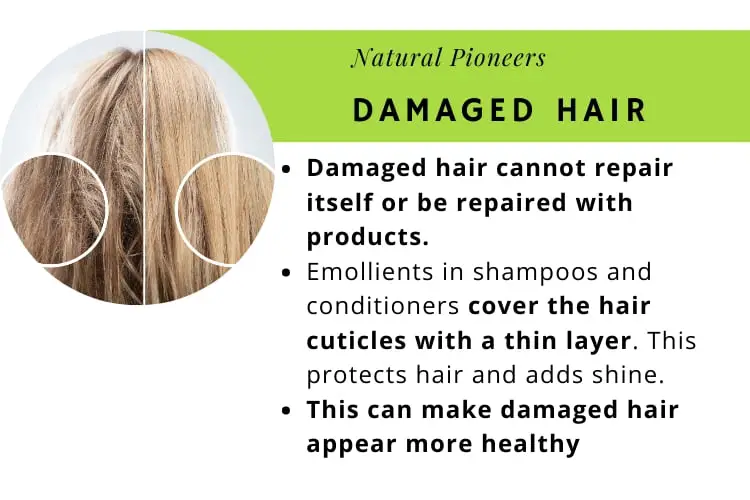
What To Do When Hair Is Already Damaged?
Since we cannot repair damaged cuticles or the cortex, here are some things we can do.
Use conditioner after every wash to add a protective layer around your hair cuticles. Eliminate external factors like exposure to the sun and smoking, eat a healthy diet with lots of essential fatty acids and vitamins, and get rid of all hair products that contain toxic chemicals. [11], [12] We’ve researched and tried some of the best toxin-free shampoos and put them in a list. You can find them at the end of this article.
Now, let’s see what shampoo really does according to studies.
2. The Science Of Shampoos
The main function of a shampoo is to clean our hair and scalp of oils, dirt, skin particles, dandruff, and environmental pollutants.
Ideally a shampoo can achieve all of this without stripping out so much that the outer hair layer, the cuticle, gets affected. Therefore, most shampoos contain a small amount of conditioner. Depositing conditioning ingredients onto the hair surfaces decrease fiber friction and makes the hair feel smooth, slick, and easier to comb. [13]
8 Functions Of Shampoo
Given the task to create a shampoo, these are the features researchers are trying to achieve.
1. To clean the hair and scalp.
2. To remove any previously applied hair products.
3. To deliver an optimum level of foam.
4. To make combing hair easier.
5. To provide hair and scalp with active ingredients (for example to treat psoriasis).
6. To be non-toxic and non-irritating to hair and scalp.
7. To be non-damaging to the eye.
8. To prevent static charge build-up. [14]
To meet most of these requirements, shampoos are typically composed of 10–30 ingredients. [15]
It has been said that the advertising, package, fragrance and color sell the first bottle of shampoo and the performance of the product sells the second bottle. [16]
However, with the aim to sell that second bottle, large corporations have increased the toxic load in their shampoos. Especially the US market is heavily impacted by that. As a comparison, the US bans 11 ingredients from shampoos, Canada bans 587, and the EU bans 1328. [17]
It’s about time we learn about all the ingredients in our shampoo that are banned in other countries. As the US life expectancy continues to decline, it is on us to take authentic action towards a healthier lifestyle including the elimination of toxic chemicals. [18]
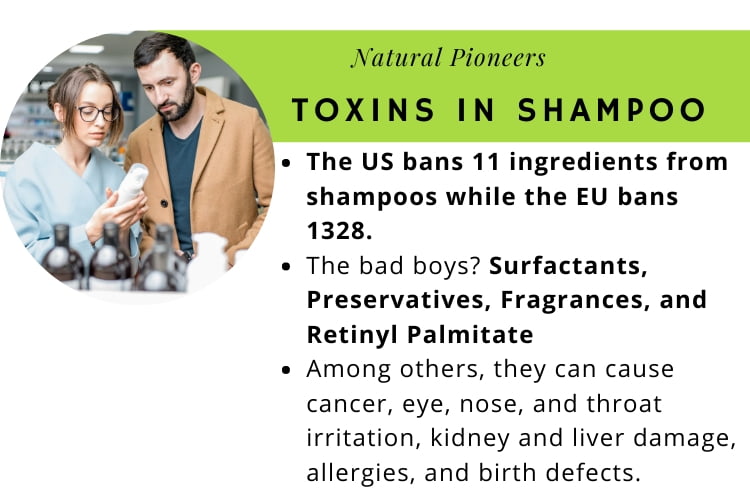
>>Learn about toxins in dish soap
3. Toxins In Regular Shampoos
Let’s see what toxins are found in most shampoos in the US and how they affect our health based on studies.
1. Surfactants
Surfactants increase a shampoo’s spreading properties allowing it to penetrate our hair evenly. Some produce bubbles, that we all enjoy while shampooing our hair. During production 1,4-dioxane is formed which is known to cause cancer. It is banned from use in the European Union. Short-term exposure may cause eye, nose, and throat irritation, long-term exposure may cause kidney and liver damage. [19], [20]
The Bad Boys: sodium lauryl sulfate (SLS), sodium laureth sulfate (SLES), cocamidopropyl betaine, and cocamide DEA. Non-toxic, safe surfactants include decyl glucoside and laurel glucoside.
The Take-Away: Use sulfate-free shampoo.
2. Preservatives
To extend shelf life, many shampoos contain preservatives. Some may cause breast cancer, are associated with immunotoxicity and allergies, or are neurotoxins. [21], [22], [23]
The Bad Boys: Parabens, benzyl alcohol, methylisothiazolinone, and methylchloroisothiazonlinone.
The Take-Away: Avoid these at all cost and check out our list of safe, non-toxic shampoos at the end of this article.
3. Smells
When you see “fragrance” or “parfum” on the ingredients list, they really mean phthaltes. Phthaltes disrupt our hormones and can harm our reproductive system. In children, they can disturb normal development. [24], [25], [26]
The Bad Boys: Phthaltes (labeled as parfum or fragrance)
The Take-Away: Go fragrance free or choose essential oils
4. Retinyl Palmitate:
Retinyl palmitate is a form of Vitamin A. It is associated with birth defects and a known carcinogen, causing an increase in skin tumors.
The Bad Boys: Retinyl palmitate
The Take-Away: Avoid retinyl palmitate at all cost and check out our list of safe, non-toxic shampoos at the end of this article. [27], [28]
Let’s now take a look at what natural shampoo is and how it compares to regular products.
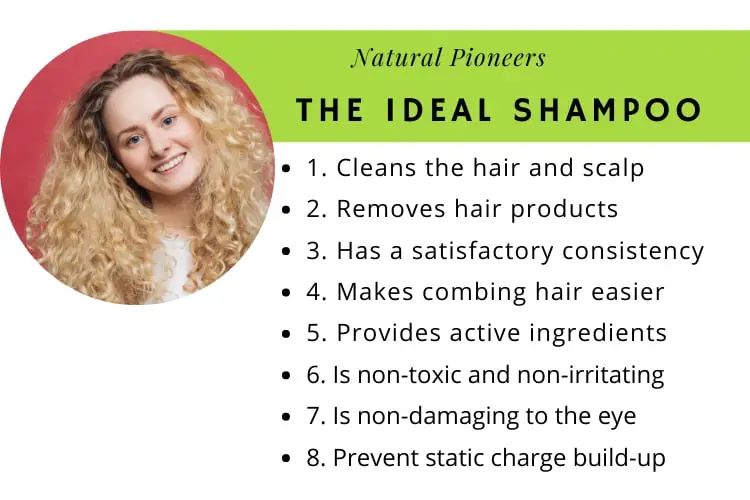
>> Read more about natural soap
4. How Is Natural Shampoo Different?
When thinking about “natural shampoo”, you might think of something non-toxic, organic, containing essential oils and herbs, that is produced without animal testing, perhaps locally made with a minimal carbon footprint and comes in a fully recyclable package. Am I right?
You need to understand that the FDA has no definitions for “natural” or “organic” in shampoo. Unlike “organic strawberries” which need to grow on organic soil and without the use of pesticides and GMOs, most shampoo is made in chemical plants.
For our purposes, we will define natural shampoo as follows:
Natural shampoo is shampoo providing the same benefits as regular shampoos while being completely safe and non-toxic.
With that in mind, let’s take a look at our options. I mention this in many articles, but I want to invite you to check all your personal care products at the EWG Skindeep Database. You can find the link here. I remember the day when I cleared-out our house from all products that didn’t meet my safety-standard. Ever since, I stayed with the following products. We switch between these 4 brands and my family uses them every day. They are safe, trusted, and personally tested.
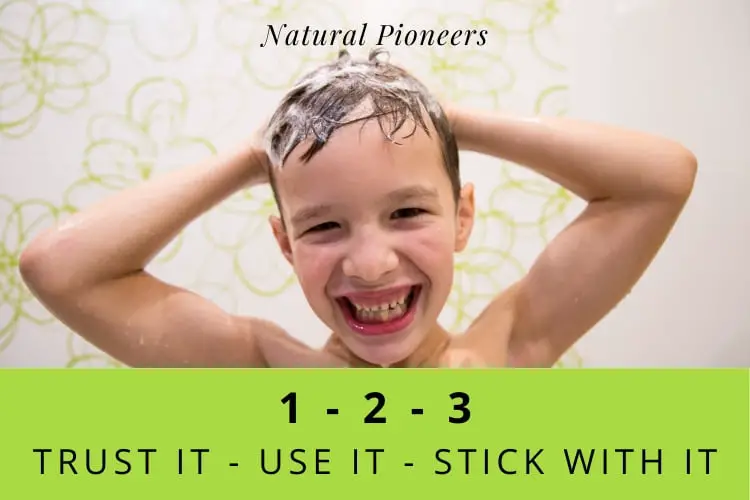
1. Attitude Super Leaves Shampoos
Why We Love It:
- Attitude shampoos come in many aromas
- EWG certified
- Bulk Eco-refills reduce plastic and keep your home stocked
2. Plaine Shampoo
Why We Love It:
- Generous 16 oz bottles
- Made with essential oils
- Their chic refill bottles reduce plastic (+optional subscription)
3. Be Green DRY Shampoo
Why We Love It:
- EWG certified
- With organic ingredients such as arrowroot and kaolin clay
- This dry shampoo is ideal for busy people or when traveling or camping
4. Conscious Skincare Organic Shampoo
Why We Love It:
- EWG certified
- With lavender and sage essential oil
- Comes in beautiful and fully recyclable glass container with dispenser (refills available)
Note: This product currently ships from the UK. Don’t get confused by the currency, they ship to the US.
>> Learn more about natural hand soap
5. Conclusion
“Healthy” hair has a sealed cuticle (outer) layer which provides ideal protection to the cortex (inner layer). This allows your hair to keep its natural strength, moisture, and hair pigment.
Since our visible hair is a dead structure, it is impossible for hair to absorb vitamins, minerals, or antioxidants from shampoo.
Therefore, it is on us to keep our hair healthy and take good care of already damaged hair. Shampoos help us get there by covering the hair cuticles with a thin layer. This adds shine, protects the hair from further breakage and has our hair appear more healthy.
A crucial step toward healthy hair is to minimize toxic exposure. Regular shampoos marketed in the US contain loads of chemicals. As a comparison, the US bans 11 ingredients from shampoos, Canada bans 587, and the EU bans 1328.
The Bad Boys? Surfactants, Preservatives, Fragrances, and Retinyl Palmitate. Not only can they do harm to your hair, but some of them are known to cause cancer (specifically skin and breast cancer) eye, nose, and throat irritation, kidney and liver damage, allergies, and birth defects. They are associated with immunotoxicity, harm our reproductive system, disrupt our hormones, can disturb normal development in children, and act as neurotoxins.
While many consumers have made the switch to “natural” shampoo, not all of them are safe. That is because the FDA has no definitions for “natural” or “organic” in shampoo. Which means any company can print the term “natural” on their bottle.
At Natural Pioneers, we define natural shampoo as: Shampoo providing the same benefits as regular shampoos while being completely safe and non-toxic. We recommend non-toxic brands like Attitude, Plaine, Be Green, and Conscious Skincare.
It is on us to learn about the ingredients in our personal care products and take action towards a healthier lifestyle, that is, the elimination of toxins around us.
